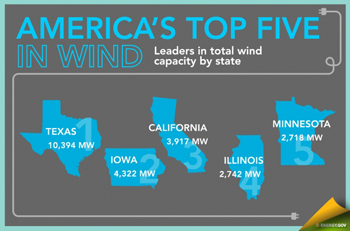forum
library
tutorial
contact

DOE Report States Wind Accounted for
32 Percent of New Generation in 2011
by Staff
Clean Edge News, August 17, 2012
|
the film forum library tutorial contact |

|
DOE Report States Wind Accounted for
by Staff
|
 The Energy Department released a new report today highlighting strong growth in the U.S. wind energy market in 2011. According to the 2011 Wind Technologies Market Report, the United States remained one of the world's largest and fastest growing wind markets in 2011, with wind power representing 32 percent of all new electric capacity additions in the United States last year and accounting for $14 billion in new investment. According the report, the percentage of wind equipment made in America also increased. Nearly seventy percent of the equipment installed at U.S. wind farms last year --including wind turbines and components like towers, blades, gears, and generators - is now from domestic manufacturers, doubling from 35 percent in 2005.
The Energy Department released a new report today highlighting strong growth in the U.S. wind energy market in 2011. According to the 2011 Wind Technologies Market Report, the United States remained one of the world's largest and fastest growing wind markets in 2011, with wind power representing 32 percent of all new electric capacity additions in the United States last year and accounting for $14 billion in new investment. According the report, the percentage of wind equipment made in America also increased. Nearly seventy percent of the equipment installed at U.S. wind farms last year --including wind turbines and components like towers, blades, gears, and generators - is now from domestic manufacturers, doubling from 35 percent in 2005.
The report finds that in 2011, roughly 6,800 megawatts (MW) of new wind power capacity was added to the U.S. grid, a 31 percent increase from 2010 installations. The United States' wind power capacity reached 47,000 MW by the end of 2011 and has since grown to 50,000 MW, enough electricity to power 13 million homes annually or as many as in Nevada, Colorado, Wisconsin, Virginia, Alabama, and Connecticut combined. The country's cumulative installed wind energy capacity grew 16 percent from 2010, and has increased more than18-fold since 2000. The report also finds that six states now meet more than 10 percent of their total electricity needs with wind power.
The growth in the industry has also led directly to more American jobs throughout a number of sectors and at factories across the country. According to industry estimates, the wind sector employs 75,000 American workers, including workers at manufacturing facilities up and down the supply chain, as well as engineers and construction workers who build and operate the wind farms.
Technical innovation allowing for larger wind turbines with longer, lighter blades has improved wind turbine performance and increased the efficiency of power generation from wind energy. At the same time, wind project capital and maintenance costs continue to decline, driving U.S. manufacturing competitiveness on the global market. For new wind projects deployed last year, the price of wind under long-term power purchase contracts with utilities averaged 40 percent lower than in 2010 and about 50 percent lower than in 2009, making wind competitive with a range of wholesale power prices seen in 2011.
Despite these recent technical and infrastructure improvements and continued growth in 2012, the report finds that 2013 may see a dramatic slowing of domestic wind energy deployment due in part to the possible expiration of federal renewable energy tax incentives. The Production Tax Credit (PTC), which provides a tax credit to wind producers in the United States and has helped drive the industry's growth, is set to expire at the end of this year. The wind industry projects that 37,000 jobs could be lost if the PTC expires. Working in tandem with the PTC, the Advanced Energy Manufacturing Tax Credit provides a 30 percent investment credit to manufacturers who invest in capital equipment to make components for clean energy projects in the United States.
learn more on topics covered in the film
see the video
read the script
learn the songs
discussion forum
